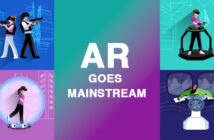AR is the gateway to immersive phase in computing history. It can really transform the way we work and we will not realize the potential of it until basic performance and usability issues are addressed. Let’s have an insight into how AR won’t advance until its optical issues are solved.
In a recent report by AR/VR Analysts state that solving two fundamental optical issues can unlock 10$ billion that we spend on enterprise AR Applications by 2026.
AR won’t advance until its optical issues are solved
As of now, AR Experiences suffer from focal rivalry and vergence accommodation conflict. These terms are unknown and anyone wearing AR Headset for a particular time can recognize them as eye fatigue.
In fact, it’s an inability to read the text close and struggle to finish precision tasks as virtual content is not well integrated with the real world. Greenlight Analysts further say that 95% of current applications will have a benefit if these issues are resolved.
What is focal rivalry and vergence accommodation conflict?
VAC breaks the way normally our eyes focus. In real world as an object gets closer our eyes will turn inwards to triangulate on it, thereby stimulating eyes to focus at a right distance. This usually will not happen in AR as lenses in headsets are fixed at a specific focal distance. Thus, our eyes will not be fooled by a clever software manipulation of virtual content.
One more challenge AR is facing is focal rivalry a phenomenon that occurs when we view virtual and real content at a time. In fact, our eyes can’t integrate both virtual and real content into genuine mixed reality unless and until they are in the same focal plane. If at all you wish to place virtual content in different distances and interact in a natural way you need to resolve this issue.
Why is this a 10$ billion issue for AR Industry?
One of the most advanced AR Headsets is Microsoft Hololens and it even stated about the problem of VAC. Microsoft suggests designers to create content scenes which encourages users to interact from a meter or farther from the content. It even adds that users need not switch from near focus to far focus as it can lead to fatigue and visual discomfort.
A research team from University of Pisa conducted a study and found how focal rivalry affects people’s performance while using AR to finish precision tasks. It found that finishing an AR assisted task in which the content is within two meters of person needs a high level of precision and this is not feasible with the existing technology.
Inability to bring content within arm’s reach and place content at any focal point is what that is holding AR back. Discomfort of VAC and eye fatigue is limiting the amount of time we usually spend on AR and is even preventing it from being an all day wearable.
Unlock the true potential of AR with Optical Interface
If we really need to unlock the true potential of AR we need to find a solution to both focal rivalry and VAC. The solution lies in a dynamic optical interface which allows users to position virtual content convincingly in 3D Space, integrate both real and virtual content without any limitations.
So many solutions are being developed to this and they range from liquid crystal displays, VPT Systems and light field displays, adaptive lenses. On a detailed comparison it is found that adaptive lenses address these issues well.
In order to enhance the augmented reality we need to integrate some or the other form of dynamic optical interface. If we achieve this we can bring a step change in both the applications and experiences that we create.




